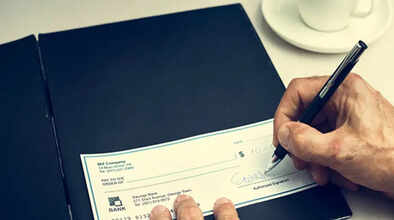Banking: If you do not correct this mistake even after the cheque bounces, then strict action can be taken, know the rules..

Check Bounce Tips: In our country, people of every class take the help of banks to deposit future capital and for financial transactions. Banks provide many types of facilities (latest banking services) to their customers for financial transactions. In this era of technology, banks are providing UPI and net banking facilities to customers for financial transactions. Even after these facilities, financial transactions through cheques in the bank have not decreased.
The utility of cheque transactions has not decreased.
Even after the advent of UPI (UPI Transaction) and net banking, there has been no reduction in financial transactions through cheques. Financial transactions in lakhs and crores are still done with the help of cheques (check transaction rule). Cheques are considered to be the safest option for financial transactions. Due to a lack of complete information about transactions through cheques, people make many types of mistakes (Check bounce Mistakes) while filling it. While filling out cheques, people face the problem of cheque bouncing the most.
What is cheque bounce?
While depositing a cheque in the bank, customers often make minor mistakes while writing the amount or signing it. Due to this, the cheque bounces. In bank language, a cheque bounce is called a dishonored Cheque). Cheque bounce is considered a punishable offense as per section 138 of the (Negotiable Instrument Act 1881). There is a provision of two years imprisonment and a fine or both for this.
What are the reasons for cheque bounce?
There can be many reasons for cheque bounce (Check bounce Punishment). In some major situations, the bank takes strict action when the cheque bounces. There are many reasons why a cheque bounces like no balance in the account or less, signature not matching, mistake in writing the word, mistake in the account number, over writing (Overwriting Check bounce), expiry of the cheque, account of the person who issued the cheque being closed, suspicion of fake cheque, no company seal on the cheque (Check bounce Signature case). In these cases, if the rules are not followed, then one may have to face legal punishment.
No action is taken for 3 months.
In case of a cheque bouncing, initially, the bank sends you a notice related to it (Check bounce Punishment case). After this, you have 3 months in which you give the second cheque to the creditor. If your second cheque also bounces, then the creditor can take legal action against you.
Provision of penalty on cheque bounce
If the bank does not follow the rules (Check bounce Fine) on a cheque bouncing, then the bank also charges a penalty from the people who issued the cheque. The fine has to be paid by the person who has issued the cheque. This fine can vary according to the reasons. For this, every bank has fixed different amounts (Check bounce Charges). Usually, a fine of Rs 150 to Rs 750 or 800 is charged.
Punishment is given after court action.
After three months of cheque bouncing, the bank takes legal action (Check bounce legal action). For three months, the bank only sends you a notice. If the debtor does not give any reply for 15 days, then court action is taken against him. The creditor can file a complaint in the magistrate's court within a month. Even after this, if he does not get the money from the debtor, he can file a case against him. If found guilty, a jail term of up to 2 years or a fine or both can be imposed.
Disclaimer: This content has been sourced and edited from Hr Breaking. While we have made modifications for clarity and presentation, the original content belongs to its respective authors and website. We do not claim ownership of the content.

